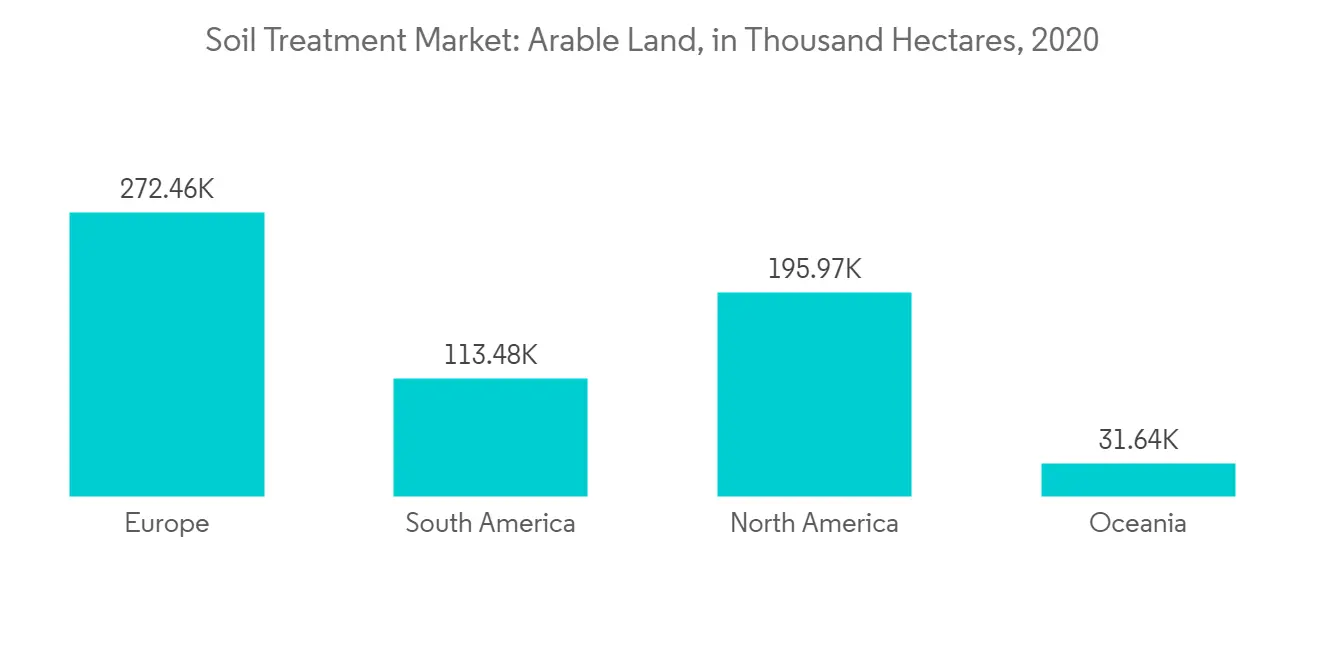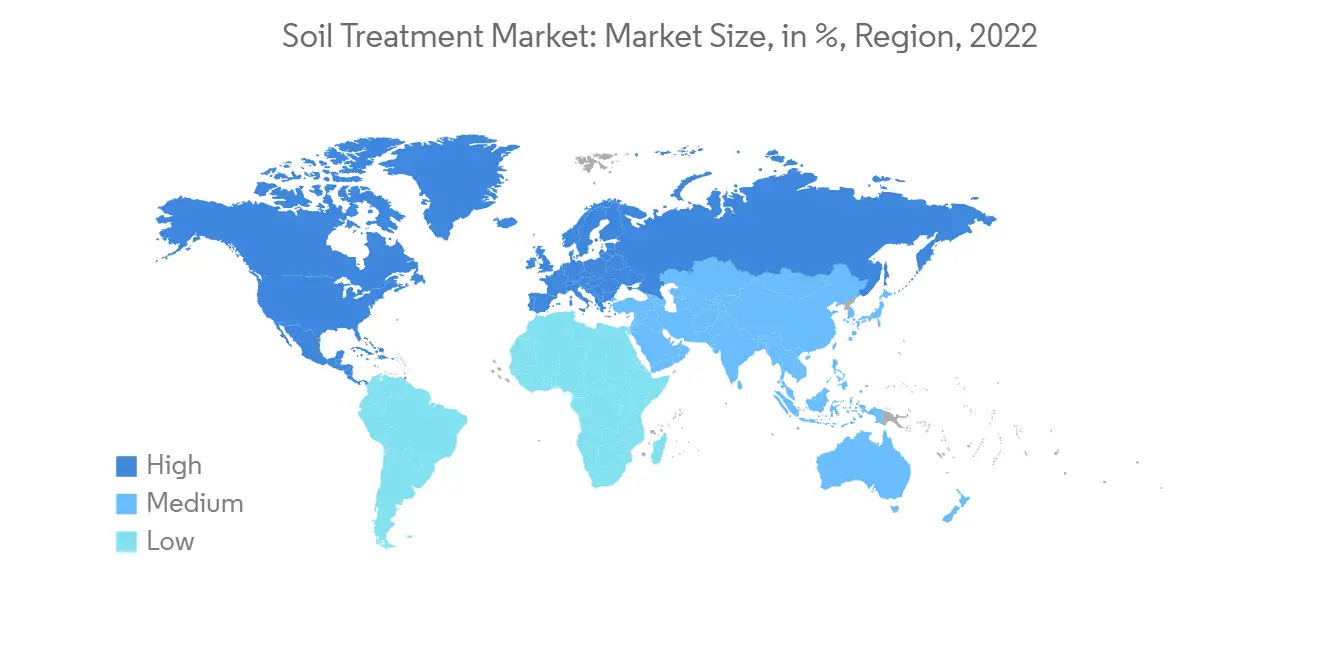 |
市場調査レポート
商品コード
1326322
土壌処理の市場規模・シェア分析- 成長動向と予測(2023年~2028年)Soil Treatment Market Size & Share Analysis - Growth Trends & Forecasts (2023 - 2028) |
||||||
● お客様のご希望に応じて、既存データの加工や未掲載情報(例:国別セグメント)の追加などの対応が可能です。 詳細はお問い合わせください。
| 土壌処理の市場規模・シェア分析- 成長動向と予測(2023年~2028年) |
|
出版日: 2023年08月08日
発行: Mordor Intelligence
ページ情報: 英文 120 Pages
納期: 2~3営業日
|
- 全表示
- 概要
- 目次
土壌処理市場規模は、2023年の418億9,000万米ドルから2028年には547億8,000万米ドルに成長し、予測期間(2023-2028年)のCAGRは5.51%になると予測されます。
主なハイライト
- 土壌処理は、汚染された土壌を農業やその他の目的に使用できるようにするために用いられます。土壌の性能と肥沃度を高めるのに役立ちます。生物学的処理またはバイオレメディエーションは、土壌中の物質を分解するバクテリアを用いて、燃料や油などの有機成分から土壌を修復するために広く用いられています。
- 生物学的処理は経済的であるが、時間がかかり、実施までに1~数ヶ月を要します。バイオレメディエーションの適否は、汚染物質、現場の状況、目標レベルによって異なります。微生物プロセスを用いた汚染土壌の浄化は、その環境に優しい特徴から効果的で信頼できることが証明されており、この分野は今後数年でさらに成長する可能性が高いです。
- 熱処理は汚染土壌を迅速かつ確実に修復できるが、エネルギーを大量に消費する性質と土壌の特性を損なう可能性があるため、持続可能性が低いと思われます。また、このプロセスは比較的高価であるため、このセグメントの市場シェアは小さいです。中国政府は2020年までに、汚染された農地の90%を農作物のための安全な農地に転換するとしています。このように、政府は国内の土壌汚染を慎重に調査しており、この期間に土壌処理産業が成長する原動力となっています。
- 2021年4月、米国農務省(USDA)の国立食糧農業研究所(NIFA)は、農業生産者が気候変動が農地や生産に及ぼす影響を管理するのを支援するためのいくつかの主要プログラムに約2,170万米ドルを投資しました。NIFAはまた、農業・食糧研究イニシアチブ(AFRI)を通じて、14の土壌健全性助成金に630万米ドル、7つの土壌中のシグナル助成金に540万米ドルを投資しました。
土壌処理市場の動向
一人当たりの耕地面積の減少と食糧需要の増加
- 国連によると、世界の人口は2022年11月中旬に80億人に達し、今後30年間で20億人近く増加し、2022年の80億人から2050年には97億人になると予想されています。人口レベルの増加に伴い、食糧需要は今後数年で倍増すると予測されています。この増加する人口に食料を供給することが懸念されています。一方、工業化と都市化により、主要農業国の耕地面積は減少しています。
- 国連食糧農業機関(FAO)が発表した2050年の資源見通しでは、世界の地表のわずか12%しか作物生産に利用されておらず、これ以上農地を拡大する余地はほとんどないです。それゆえ、土壌処理製品を使用してより多くの食糧を生産するために、既存の耕地に圧力がかかっています。
- FAOによれば、北米、欧州、南アジアなどの先進国では、耕地面積が5,400万ヘクタール減少しています。本研究の予測によれば、耕地面積はさらに緩やかに減少し、2030年には6億800万ヘクタール、2050年には5億8,600万ヘクタールになります。
- 土壌処理製品を適切かつバランスよく使用することで、利用可能な耕作地を使って増加する人口を養うことができるかもしれないです。
- 農地の減少に加えて、微量栄養素の欠乏が世界的に広がっており、アジア太平洋はこの欠乏の影響を受けている主要地域のひとつです。穀物作物土壌の半分以上が亜鉛欠乏症であり、耕作土壌の約3分の1が鉄欠乏症です。土壌の40~55%は亜鉛が、25~35%はホウ素が、約10~15%はその他の微量栄養素が、それぞれ中程度に欠乏していると推定されます。土壌中の微量栄養素の欠乏が大きいため、作物は肥料や農薬に反応せず、収穫量の減少につながっています。この問題は、Ph調整剤を使用することで対処できます。

北米が市場を独占
- 米国、カナダ、メキシコのような北米諸国では、土壌汚染と修復に関する懸念が高まっており、これが農地の土壌処理の引き金となっています。土壌は生態系の重要な構成要素であり、人間の幸福と自然システムを支える幅広い生態系サービスを提供しています。土壌は農業生産の基盤であり、作物に養分と水を供給し、食料、繊維、燃料を供給する植物の成長を支えています。
- 土壌はまた、水と栄養分の循環に重要な役割を果たし、水と汚染物質のフィルターとして機能し、水の流れを調整し、浸食を防ぐ。米国農務省(USDA)は、2020年中の土壌および土壌関連物質の輸入および国内移動に関する植物検疫要件を規定した指令を策定しました。これには、土壌および土壌で汚染された物品(丸太や材木、車両、設備、工具、容器など)に関する要件が含まれています。
- カナダ食品検査庁(CFIA)によると、カナダの土壌には生物の数が多く複雑なため、このような害虫がいない土壌にすることはほぼ不可能だといいます。そのため、土壌を媒介とする重要な検疫害虫がカナダにイントロダクションし、蔓延するリスクを抑えるために、土壌に関する厳格な植物検疫措置が必要となっています。2021年、カナダ政府はカナダ食品検査庁(CFIA)に今後5年間で1億6,260万米ドル、継続的に年間4,000万米ドルを投資し、カナダの食品安全システムの完全性を維持し、食品供給の保護から動植物の健康を守り、土壌浸食や世界貿易の不安定性を克服するためにカナダ企業の輸出入活動を継続的に支援します。それゆえ、同国では土壌処理に関する十分な認識があり、それが同国の市場を牽引しています。
- メキシコでは、土壌の浄化は廃棄物防止・管理法(LPMW)によって規制されており、その規定では、有害化学物質によって土壌が汚染された場合、差し迫った健康リスクや環境を防止または低減するための早急な浄化措置を実施することが義務付けられています。これらの法律は、国内での土壌処理製品の使用を推奨しています。
- メキシコにおける農薬による土壌汚染は深刻な問題であり、さまざまな研究グループが、農薬の生分解を評価する生物学的戦略や、農薬で汚染された場所の処理、修復、無害化のためのバイオ減衰、バイオ刺激、バイオオーグメンテーション、バイオオーグメンテーション・コンポスト方式を開発しています。このことは、土壌処理市場が国内で急速に普及していることを示唆しています。

土壌処理業界の概要
調査対象市場は非常に断片化されており、多数の企業が市場シェアを握っています。しかし、Bayer Crop Science AG、Corteva AgriScience、BASF SE、Syngenta、AMVAC Chemical Corporationといった企業が、市場でのシェア強化に努めています。世界の土壌処理市場では、企業は革新的な製品の発売とともに、戦略的なM&Aや事業拡大も重要な戦略として採用しています。革新や拡大とともに、研究開発への投資や新規製品ポートフォリオの開発も、今後数年間は重要な戦略となりそうです。
その他の特典:
- エクセル形式の市場予測(ME)シート
- アナリストによる3ヶ月間のサポート
目次
第1章 イントロダクション
- 調査の前提と市場定義
- 調査範囲
第2章 調査手法
第3章 エグゼクティブサマリー
第4章 市場力学
- 市場概要
- 市場促進要因
- 市場抑制要因
- ポーターのファイブフォース分析
- 供給企業の交渉力
- 買い手・消費者の交渉力
- 新規参入業者の脅威
- 代替品の脅威
- 競争企業間の敵対関係の強さ
第5章 市場セグメンテーション
- 技術分野
- 物理化学的処理
- 生物処理
- 熱処理
- 種類
- 有機添加剤
- pH調整剤
- 土壌保護
- 地域
- 北米
- 米国
- カナダ
- メキシコ
- その他北米地域
- 欧州
- スペイン
- 英国
- フランス
- ドイツ
- イタリア
- その他欧州
- アジア太平洋
- 中国
- 日本
- インド
- オーストラリア
- 韓国
- その他アジア太平洋地域
- 南米
- ブラジル
- アルゼンチン
- その他南米
- アフリカ
- エジプト
- 南アフリカ
- その他のアフリカ
- 北米
第6章 競合情勢
- Most Adopted Competitor Strategies
- 市場シェア分析
- 企業プロファイル
- Bayer CropScience AG
- American Vanguard Corporation
- Syngenta
- BASF SE
- Novozymes AS
- Soil works LLC
- DOWA ECO-SYSTEM Co. Ltd
- Isagro SpA
- ADAMA Ltd(Makhteshim Agan Group)
- Southern Petrochemical Industries Corporation(SPIC)Limited
- SA Lime & Gypsum
- Soil Technologies Corp.
- SWAROOP AGROCHEMICAL INDUSTRIES
- SAINT GOBAIN
- Rallis India Limited
- Ohp Inc.
- Agro phos india limited
- Terracottem Australasia Pty Ltd
- Terramanus Technologies LLC
- KANESHO SOIL TREATMENT SRL/BV
- Platform Specialty Products
- Sardar Bio Chem
- International Rehabilitation and Soil Stabilization Services(IRASSS)
- UPL Limited
- Corteva Agriscience
第7章 市場機会と今後の動向
The Soil Treatment Market size is expected to grow from USD 41.89 billion in 2023 to USD 54.78 billion by 2028, at a CAGR of 5.51% during the forecast period (2023-2028).
Key Highlights
- Soil treatment can be used to make contaminated soil usable for agriculture and other purposes. It helps enhance the performance and fertility of the soil. Biological treatment or bioremediation is widely used to remediate soil from organic components like fuel or oils using bacteria to break down the substances in the soil.
- Although biological treatment is economical, it is time-consuming and takes as long as 1 to several months to be carried out. The suitability of bioremediation depends on the contaminants, site conditions, and target levels. Remediation of polluted soil using microbial processes has proven effective and reliable due to its eco-friendly features, and the segment is likely to grow further in the coming years.
- Thermal treatment can remediate contaminated soil rapidly and reliably, but its energy-intensive nature and potential to damage soil properties make it seem less sustainable. The process is also comparatively more expensive; hence, the segment holds a smaller market share. By 2020, the Chinese government had turned 90% of the contaminated farmland into safe agricultural land for crops in China. As such, the government's careful examination of soil pollution in the country gave an impetus for the soil treatment industry to grow during that period.
- In April 2021, the United States Department of Agriculture's (USDA) National Institute of Food and Agriculture (NIFA)invested around USD 21.7 million in several key programs to help agricultural producers manage the impacts of climate change on their lands and production. NIFA also invested USD 6.3 million for 14 Soil Health grants and $5.4 million for seven Signals in the Soil grants through its Agriculture and Food Research Initiative (AFRI).
Soil Treatment Market Trends
Decreasing Per capita Arable Land and Increasing Demand For Food
- According to the United Nations, the global human population reached 8 billion in mid-November 2022 and is expected to increase by nearly 2 billion persons in the next 30 years, from 8 billion in 2022 to 9.7 billion in 2050. With the increasing population levels, the demand for food is projected to double in the years to come. Supplying food to this growing population has become a concern. On the other hand, due to industrialization and urbanization, the area of arable land in major agricultural countries is declining.
- As per the resource outlook for 2050 released by the Food and Agriculture Organization (FAO), only 12% of the global land surface is used for crop production, and there is little scope for further expansion of agricultural land. Hence, there is pressure on the existing arable land to produce more food by using soil treatment products.
- As per the FAO, there is a decline of 54 million hectares of arable land in developed countries in regions like North America, Europe, and South Asia. The projections of this study indicate a further slow decline in the area of arable land to 608 and 586 million hectares in 2030 and 2050, respectively.
- Adequate and balanced use of soil treatment products may help feed the growing population using the available cultivable land.
- In addition to the declining agricultural land, micronutrient deficiency is widespread globally, and Asia-Pacific is one of the major regions affected by this deficiency. Over half of the cereal crop soils are zinc deficient, and around one-third of the cultivated soil is iron deficient. It is estimated that 40-55% of the soils are moderately deficient in zinc, 25-35% in Boron, and approximately 10-15% in other micronutrients. Due to large micronutrient deficiencies in the soil, crops are not responding to fertilizers and pesticides, leading to lesser yield. This issue can be addressed by using Ph adjusters.

North America Dominates the Market
- The increasing concern about soil contamination and remediation in the North American countries like the United States, Canada, and Mexico have triggered soil treatments in the cropland. Soils are a vital component of ecosystems and provide a wide range of ecosystem services that support human well-being and natural systems. Soils are the foundation for agricultural production, providing nutrients and water to crops and supporting the growth of plants that provide food, fiber, and fuel.
- Soils also play a crucial role in water and nutrient cycling, acting as a filter for water and pollutants, regulating water flow, and preventing erosion. The United States Department of Agriculture (USDA) has laid down directives specifying the phytosanitary requirements for the import and domestic movement of soil and soil-related matter during 2020. It includes requirements for soil and items contaminated with soil, such as logs or lumber, vehicles, equipment, tools, and containers.
- According to the Canadian Food Inspection Agency (CFIA), the number and complexity of organisms in the soil in Canada make it nearly impossible for soils to be free of such pests. As a result, strict phytosanitary measures concerning soil are made necessary to limit the risks of the introduction and spread of significant soil-borne quarantine pests into Canada. In the year 2021, the Government of Canada is invested USD 162.6 million in the Canadian Food Inspection Agency (CFIA) over the next five years and USD 40 million per year on an ongoing basis to maintain the integrity of Canada's food safety system, protect the health of plants and animals from safeguarding the food supply, and provide ongoing support to Canadian businesses in their export and import activities to overcome soil erosion, and global trade volatility. Hence, there is adequate awareness in the country about soil treatment, and it is driving the market in the country.
- In Mexico, the remediation of soils is regulated by the Law for the Prevention and Management of Waste (LPMW), under whose provisions it is mandated that when hazardous chemicals contaminate a soil, immediate remedial action to prevent or reduce imminent health risks and the environment must be performed. These laws favor the use of soil treatment products in the country.
- The pesticide soil pollution in Mexico is a serious concern, and different research groups have developed biological strategies for assessing pesticide biodegradation, and bioattenuation, biostimulation, bioaugmentation, and bioaugmentation composting schemes for the treatment, remediation, and detoxification of pesticide-contaminated sites. This suggests that the market for soil treatment is rapidly gaining popularity in the country.

Soil Treatment Industry Overview
The market studied is highly fragmented, with numerous players holding the market share in the market. However, companies such as Bayer Crop Science AG, Corteva AgriScience, BASF SE, Syngenta, and AMVAC Chemical Corporation are some players striving to strengthen their market share in the market. In the global soil treatment market, companies, along with innovative product launches, are also focusing on strategic mergers and acquisitions and expansion as their key adopted strategies. Along with innovations and expansions, investments in R&D and developing novel product portfolios will likely be crucial strategies in the coming years.
Additional Benefits:
- The market estimate (ME) sheet in Excel format
- 3 months of analyst support
TABLE OF CONTENTS
1 INTRODUCTION
- 1.1 Study Assumptions and Market Definition
- 1.2 Scope of the Study
2 RESEARCH METHODOLOGY
3 EXECUTIVE SUMMARY
4 MARKET DYNAMICS
- 4.1 Market Overview
- 4.2 Market Drivers
- 4.3 Market Restraints
- 4.4 Porter's Five Forces Analysis
- 4.4.1 Bargaining Power of Suppliers
- 4.4.2 Bargaining Power of Buyers/Consumers
- 4.4.3 Threat of New Entrants
- 4.4.4 Threat of Substitute Products
- 4.4.5 Intensity of Competitive Rivalry
5 MARKET SEGMENTATION
- 5.1 Technology
- 5.1.1 Physiochemical Treatment
- 5.1.2 Biological Treatment
- 5.1.3 Thermal Treatment
- 5.2 Type
- 5.2.1 Organic Amendments
- 5.2.2 pH Adjusters
- 5.2.3 Soil Protection
- 5.3 Geography
- 5.3.1 North America
- 5.3.1.1 United States
- 5.3.1.2 Canada
- 5.3.1.3 Mexico
- 5.3.1.4 Rest of North America
- 5.3.2 Europe
- 5.3.2.1 Spain
- 5.3.2.2 UK
- 5.3.2.3 France
- 5.3.2.4 Germany
- 5.3.2.5 Italy
- 5.3.2.6 Rest of Europe
- 5.3.3 Asia-Pacific
- 5.3.3.1 China
- 5.3.3.2 Japan
- 5.3.3.3 India
- 5.3.3.4 Australia
- 5.3.3.5 South Korea
- 5.3.3.6 Rest of Asia-Pacific
- 5.3.4 South America
- 5.3.4.1 Brazil
- 5.3.4.2 Argentina
- 5.3.4.3 Rest of South America
- 5.3.5 Africa
- 5.3.5.1 Egypt
- 5.3.5.2 South Africa
- 5.3.5.3 Rest of Africa
- 5.3.1 North America
6 COMPETITIVE LANDSCAPE
- 6.1 Most Adopted Competitor Strategies
- 6.2 Market Share Analysis
- 6.3 Company Profiles
- 6.3.1 Bayer CropScience AG
- 6.3.2 American Vanguard Corporation
- 6.3.3 Syngenta
- 6.3.4 BASF SE
- 6.3.5 Novozymes AS
- 6.3.6 Soil works LLC
- 6.3.7 DOWA ECO-SYSTEM Co. Ltd
- 6.3.8 Isagro SpA
- 6.3.9 ADAMA Ltd (Makhteshim Agan Group)
- 6.3.10 Southern Petrochemical Industries Corporation (SPIC) Limited
- 6.3.11 SA Lime & Gypsum
- 6.3.12 Soil Technologies Corp.
- 6.3.13 SWAROOP AGROCHEMICAL INDUSTRIES
- 6.3.14 SAINT GOBAIN
- 6.3.15 Rallis India Limited
- 6.3.16 Ohp Inc.
- 6.3.17 Agro phos india limited
- 6.3.18 Terracottem Australasia Pty Ltd
- 6.3.19 Terramanus Technologies LLC
- 6.3.20 KANESHO SOIL TREATMENT SRL/BV
- 6.3.21 Platform Specialty Products
- 6.3.22 Sardar Bio Chem
- 6.3.23 International Rehabilitation and Soil Stabilization Services (IRASSS)
- 6.3.24 UPL Limited
- 6.3.25 Corteva Agriscience
